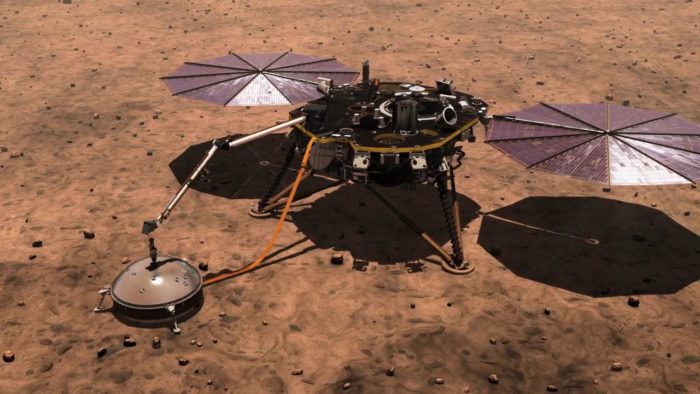Feb 25 2020
Marsquakes and Magnetic Fields on Mars
 The Mars InSight lander is yielding data, and the first slew of papers reporting early results. The two big stories so far is that Mars has more seismic and magnetic activity than previously thought.
The Mars InSight lander is yielding data, and the first slew of papers reporting early results. The two big stories so far is that Mars has more seismic and magnetic activity than previously thought.
One open question is how much tectonic activity there is on Mars. Earth has at least 15 tectonic plates, all moving with respect to each other. When two plates rub up against each other, building up and then releasing energy, this is the major source of Earthquakes. Both Mercury and the Moon, which are smaller and therefore cooled much faster than Earth, have single crust plates. That doesn’t mean they have no seismic activity, because they are also shrinking as their cores continue to cool.
Mars is still a bit of an open question in terms of tectonic activity. It appears likely that Mars does have a tectonic plate system, but much simpler than Earths with fewer plates, and they are moving much more slowly. But this still can allow for some seismic activity. There are other sources of activity as well, such as shrinking and settling. Information on seismic activity from InSight was anticipated to help better understand the geological activity on Mars.
What they have found so far is:
“We identify 174 marsquakes, comprising two distinct populations: 150 small-magnitude, high-frequency events with waves propagating at crustal depths and 24 low-frequency, subcrustal events of magnitude Mw 3–4 with waves propagating at various depths in the mantle.”
That’s a lot of quakes, much more than the Moon, but also much less than Earth. In fact, so far Insight has found 450 quakes since November 2018, but they all have not been analyzed yet. InSight itself appears to be on a fairly stable patch of land, mostly sand. It can detect quakes from far away, however. The Mars crust seems to disperse quakes far, so InSight is detecting lots of distant soft quakes, on average about one per day.
Another paper reports that Mars under InSight has a persistent hum, like a low-frequency bell. NASA scientists are still unsure what is causing it. One hypothesis is that the Marsquakes are causing some structure to vibrate, like a bell. They liken it to singing near a bell – if a vocal frequency resonates with the bell, it will ring. But this is just a hypothesis – currently a mystery to be solved. But something beneath InSight is humming.
Yet another paper (five in total were published simultaneously in Nature and Nature Communications) indicates that InSight has detected a local magnetic field 10 times stronger than anticipated from satellite data. For background, planetary magnetic fields on rocky planets like the Earth come from the rotation of a liquid iron core. That rotating core acts like a dynamo, generating the magnetic field. Earth’s magnetic field is very important, because it shield our planet from the solar wind.
Mars also had a central iron dynamo at its core, but that cooled to a halt about 4.1 billions of years ago, and with it the magnetic field shut down. However, while the magnetic field was active it aligned ferromagnetic minerals in the crust of Mars. These aligned minerals now still generate a patchwork of local small magnetic fields. That is what InSight expected to detect.
Not only was the local magnetic field stronger than anticipated (although still weaker than Earth’s), they were able to date the rocks to 3.9 billion years old. That might mean that the global magnetic field of Mars survived for 200 million year longer than previously thought. I’m not sure if this makes much of a difference, but it does help us model Mars geology and history more accurately. But the scientists warn that these results are preliminary and uncertain.
The magnetic field of Mars, like that on Earth, also fluctuates. On Earth this is due to the solar wind, which energizes the magnetic field on the day-side of the Earth, which then weakens slightly on the night-side. The same thing apparently happens on Mars, although the fluctuations are less predictable. So far scientists have not been able to detect a pattern in the fluctuations, and therefore don’t know the cause. They will have to analyze the data, along with other data from the MAVEN probe in orbit around Mars, to try to figure that out.
We have been investigating Mars for decades, but there is still a great deal we don’t know about it. Each new probe, equipped with new instruments, gives us more data and answers questions while generating new ones. The Mars 2020 Rover, set to launch this July, will hopefully address the greatest question about Mars – is there now or has there ever been any life on Mars.
The rover will also further study the climate and geology of Mars, and unlike the lander, will have the ability to move around (hence “rover”). Part of the mission of the Mars 2020 Rover is also to provide data to specifically prepare for human exploration of Mars. The primary experiment to do this is to test the feasibility of generating oxygen from the Martian atmosphere. But all of the data on climate and geology will also help future Mars explorers to predict the weather and other events, which will be critical for safety.
Robotic exploration of Mars continues to be extremely successful, and no doubt NASA will continue this mission. Whether or not, and how soon, we transition to human exploration remains to be seen. But if we do, the robots will have paved the way.






